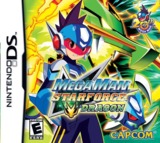As a longtime fan of the series, this game is a huge letdown. Yet, it still manages to attract my addiction.
Upon sadly finishing the Battle Network Series, I was saddened at the fact that I wouldn't be able to enjoy a nice RPG like this one, that mixed it up a bit. Then I saw the trailers for Starforce.
The Good:
-A nice throwback to the Battle Network Series
-Some of the new features like online trading and the new battle system are intriguing.
-The "Battle Card" system is much easier to use than the old way.
-The story is nice.
The Bad:
-Other than the battle graphics, which are god awful by the way, the game looks as if it was ported directly from a GBA game.
-The game proceeds episodically. Bad Capcom.
-While the story is nice, the game has some pacing problems, and the story leaves a lot more to be desired. It's in these terms that I find the anime to be a better source of story and backround.
-A lack of content overall, the game is rather short, paling in comparison to Battle Network 3, where I spent over 100 hours on one file.
-The brother band system is boring, and while it spreads communication, it seems almost forced onto the player as well as getting rid of the Navi-Cust. system.
Capcom has gone into quite bad pattern since the third instalment of their critically acclaimed Battle Network Series. Starforce takes place about 200 years after the escapades of Lan and his crew and introduces a new protagonist, who is almost the exact opposite of Lan.
Meet Geo Stelar, the cheesy named, spiky haired youth who you play as throughout the game. As Geo you explore the human world, though, the game is rather limiting on this in the beginning. There isn't much to do, because Geo likes to isolate himself from other humans since a tragic accident three years ago.
Eventually, you meet an FM-ian (alien) named Omega-Xis, who activates special goggles on Geo's forehead. Other FM-ians have followed Omega-Xis down to Earth, and plan to launch an attack to obtain something called the Andromeda Key, an item that Omega-Xis has.
From then on, you have the ability to fuse with Omega-Xis and become Megaman, and explore the world of radio waves. This world is a major letdown and pales in comparison to the creative net worlds of old, alas, it will suffice though. As mentioned before, the game progresses episodically from then on out, with many people in Geo's life becoming controlled by other FM-ians including a famous celebrity named Sonia Strumm, who becomes a strong supporting character as Harp-Note.
The controls are simple, and are once again a throw back to Battle Network, with only a few differences. The Y button puts on Geo's visualizer and allows him to see the wave world as a human. The X-button serves as the start button as well, other than that, everything about the game has remained the same. The touch screen controls are forced on the player. In an attempt to cheaply harness DS' touch screen, the player will be forced to do certain gimmicks meant to entertain casuals, which don't really help the game at all and have no real meaning to them.
The graphics and sound are completely ported. Everything from the explosions, to the text menu sound could have easily been done on Battle Network, as well as the graphics being the same style they were before. No effort was put in on Capcom's part to improve the game's graphics or sound at all.
The battles are the biggest difference from Battle Network. Now, instead of fighting an opponent on a 3 by 6 grid, you fight on a 3 by 5 grid, in which you are facing behind Megaman and are limited to only moving to the three spaces where Megaman is standing. This takes away a lot of strategy that was used in the old games but was able to justify Capcom adding the ability to shield against indirect attacks with the Y button, and simplifying the "Battle Card" system, making stringing attacks together easier.
Unfortunately, the graphics in the battle system are extremely jagged and hardly fluent at all. The sounds are once again put in directly from the Battle Network games.
Each of the three versions has a few distinct differences. There are five cards called Giga Cards, that are unique to each version as well as each version of the game assigning you a different "Sattelite Admin." The Admins are either Leo, Dragon, or Pegasus, based on which version you picked up. At the midpoint of the game, the corresponding Admin will battle you and grant you powers based in his image. This is much like the "Beast-Out" system in Battle Network, but is once again limited and only usable when you draw the card to activate it.
With all this negativity, you would expect Starforce to have been granted a much lower score. Starforce is an either love it or hate it game. If you don't mind the letdown and gameplay features that pale in comparrison to its predecessors, then go for it and love it. Some people will hate the flaws of this game to the point of returning it.
Overall, this game is not better than it's predescessors. It is still a "Battle Network Experience" though, which makes up for the crummy production values and limiting ideas put in this game. Hopefully, Capcom can improve upon this series with the sequal launching in June.

